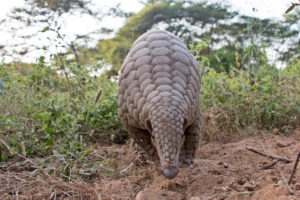In India’s forests, grasslands and shrublands, one may, with some luck, come across tigers, leopards, elephants, various deer species and innumerable birds. But it takes a lot of luck to encounter a pangolin. These shy, burrow-dwelling anteaters – the world’s only scaled mammals – play a vital role as ecosystem engineers. As they build their burrows, they help to circulate organic matter in the soil and increase soil moisture and aeration, which is beneficial to plant communities. By feeding on ants and termites, they help to regulate populations of the insects.
Globally, eight pangolin species are found in Africa and Asia, and India is home to two: the Indian pangolin and the Chinese pangolin. The Indian pangolin, assessed as globally Endangered on International Union for Conservation of Nature (IUCN) Red List, is found across India up to the foothills of the Himalayas, while the Chinese pangolin, Critically Endangered on the IUCN Red List, is restricted to the terai of eastern and north-eastern India.
All pangolins are threatened due to the illegal wildlife trade, as their scales are used in traditional medicines, particularly in East and Southeast Asia, and their meat is consumed across their range, including in India. Despite international trade in all pangolin species and their body parts and derivatives being prohibited under CITES (the Convention on International Trade in Endangered Species of Wild Fauna and Flora), pangolins are reported to be the most heavily trafficked wild mammals in the world. In India, both the Indian and Chinese pangolin are listed on Schedule I of the Wild Life (Protection) Amendment Act, 2022, which prohibits hunting, trade and any other form of utilisation of the species or their body parts and derivatives.
Pangolin trafficking in India – the data
A new factsheet produced by the India office of TRAFFIC, a non-governmental organisation that monitors wildlife trade, analyses seizures of pangolins and their parts in India from 2018 to 2022, drawing on open-source print and online media reports. The analysis is part of TRAFFIC’s continued efforts to highlight illegal trade affecting endangered species in India, especially lesser-studied and Schedule I species.
The analysis included 342 reported seizure incidents, in which a total of at least 1,203 pangolins were taken from the wild for illegal trade in India. In most cases, the species (Indian or Chinese) was not specified. 50% of seizure incidents involved live pangolins, accounting for 199 animals in total. Pangolin scales were found in 40% of reported seizures, but represented many more pangolins, at an estimated 943 animals. Other pangolin derivatives seized included carcasses (15 animals from 11 seizures), skins (29 animals from seven seizures), claws, meat, and bones.
Among India’s states, Odisha reported the highest number of seizures overall (74 incidents) and was also the state with the highest number of reported seizures of live pangolins (45 incidents involving 50 pangolins), followed by Maharashtra (27 incidents, involving 32 pangolins).
Odisha also reported the most seizures of pangolin scales (30 incidents, accounting for 103 pangolins), followed by Madhya Pradesh (26 incidents, representing 111 pangolins). But looking at the number of pangolins involved in seizures of scales, Karnataka came top, with scales seized in 14 incidents equating to 129 pangolins, followed by Tamil Nadu, where the scales of 125 pangolins were seized in just three incidents.
At least 1,203 pangolins
taken from the wild for illegal trade in India between 2018 and 2022, based on analysis of seizure data
Compared with TRAFFIC’s previous analysis of pangolin trade in India, the data shows a slight shift in states reporting seizures. In the new assessment, a majority of seizures were reported from the eastern and central regions of India, whereas the north-eastern state of Manipur represented the biggest share of reported seizure incidents in 2009-17. The states of eastern and central India still have significant forest cover, even outside protected areas, and this may indicate that these forest areas are being targeted by poachers to extract pangolins for illegal trade. However, increased efforts by conservation law enforcement agencies may also have contributed to increased detection of cases, while reporting effort also undoubtedly impacts on the data significantly.
While it is difficult to draw conclusions about trafficking routes from open-source data, some sources have reported trafficking of pangolins from India to China via routes including Myanmar and Nepal.
The scale of illicit pangolin trade paints a grim picture of the future of pangolins in India. However, with strong domestic and international protection for India’s pangolins, and enforcement actions to curb poaching and trafficking (as evidenced by the number of seizure incidents across India), steps are being taken to secure the future of the scaly mammals. These efforts are being complemented by initiatives from government and non-government organisations to increase awareness of the issue among various stakeholders.
What needs to be done
Knowledge and understanding of pangolins, such as how to differentiate between India’s two species, is critical for officials at India’s Forest Department to understand the illegal trade and make informed decisions to protect and conserve the species. As pangolin trafficking spans multiple borders, standardised techniques to identify pangolin scales and DNA-based methods to pinpoint both the species and the areas or regions being impacted by poaching is the need of the hour.
This can be helped by institutionalising training on identification of pangolin derivatives for conservation law enforcement at agencies such as Forest Training Institutes; police training academies in each state; the National Academy of Customs, Indirect Taxes and Narcotics; and the training institutes of the Central Armed Police Forces.
Pangolins may live in burrows, but India’s policymakers need not let their plight remain buried
Illegal trade in pangolins is also being observed on social media and online platforms in India and internationally, which poses serious concerns . The TRAFFIC analysis recorded eight incidents of pangolins and their derivatives being traded online in India. Such platforms can allow direct trading and money transfer between traffickers and buyers in spaces where law enforcement interventions can be difficult. There is an urgent need for law enforcement agencies to monitor online trade in pangolins and other protected species in collaboration with e-commerce and social media companies. Existing collaborative initiatives such as the Coalition To End Wildlife Trafficking Online are showing positive results worldwide, and this needs to be replicated within India.
Pangolins may live in burrows, but India’s policymakers need not let their plight remain buried. Effectively addressing the illegal trade in pangolins would prevent organised crime networks from exploiting India’s precious and fragile biodiversity, while saving pangolins will ensure that they can continue to play their crucial ecological roles in keeping India’s habitats healthy.









